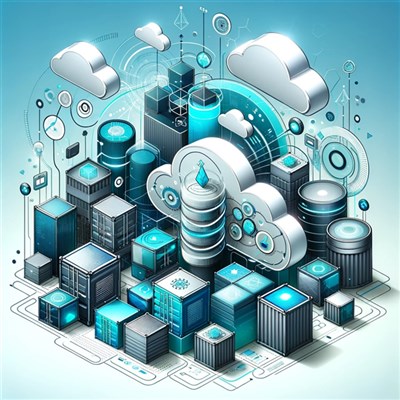
The global pandemic accelerated the ongoing shift towards virtualisation. Through 2020-21, the cloud computing revolution took over nearly every industry, sector and market around the world. This shift towards remote working and cloud platforms is only bound to grow in 2023, with companies now adopting remote working as a full-time model.
Enhancing cloud platform capabilities through various technologies and tools is going to be the largest trend in 2023. There will also be multiple new applications for cloud technology that weren’t possible before. Here are a few reasons and trends that will see cloud computing reach new heights in the coming year.
10 Cloud Computing Trends for 2023
Take a look at the top trends in cloud computing that you can explore in the new year.
1. Multi-cloud/ Hybrid cloud solutions:
A hybrid cloud solution combines the features and functionalities of a third-party public cloud platform with a private cloud solution. Such a solution will generally be used to enable workloads to move from public to private clouds and back. This will give users greater flexibility for data sharing and access.
2. Disaster recovery and backup:
Data outages, system failures and cyber attacks are a huge part of running a digitally integrated business. Enterprises have generally dealt with server or system crashes that lead to a loss of unsaved documents or data. To prevent or minimise such instances and ensure there’s no loss to enterprise processes and infrastructure, disaster recovery and data backup are critical applications of cloud computing. According to reports by Spiceworks, 15% of all enterprise cloud budgets are dedicated to disaster recovery and backup. This is the largest budget allocation, with productivity tools and email hosting coming in close behind.
A cloud solution dedicated to disaster recovery and backup is a strong contingency plan. The enterprise system automatically maintains electronic or virtual records of documents and stores them on its external cloud server.
3. Serverless Architecture:
Serverless architecture within an enterprise’s infrastructure eliminates all the barriers that are placed by traditional IT infrastructure. You don’t need to rent or purchase the servers used for running data. Instead, there’s a dedicated third party that can handle this for you. This allows your business to focus on other more productive tasks.
There are many advantages of serverless enterprise architecture. It gives you several benefits such as:
-
Easy operational management
-
Reduced liability
-
No need for system administration
-
Improved offline experience
-
Lower costs
4. AI platforms:
As technology evolves, AI is going to be one of the most valuable technology trends to work together with cloud computing. Technology conglomerates are exploring new ways to incorporate AI for Big Data processing. This aims at improving business functions and output.
Using AI solutions and infrastructure, cloud platforms aim to increase efficiency. AI enables organisations to manage and automate internal processes smartly. This framework also helps them to adapt and scale to their evolving business needs more easily. In other words, the collaboration between AI and cloud computing is going to become a leading trend soon enough. This is proved by an IBM study that revealed 65% of businesses agree that AI is critical for business success and strategy.
5. Cloud security:
The threat of data leaks, deletion and fraud have made data and network security a huge challenge for all IT infrastructures today. With more businesses switching to the cloud, enterprises need to ensure cloud service providers have airtight security protocols and systems to ensure the safety of client data.
One thing to note is that cloud security is more than a trend in a single year. It’s a fundamental part of cloud infrastructure solutions that every organisation should prioritise. Additionally, the GDPR (General Data Privacy and Management) that was rolled out in 2018 increased the obstacles towards cloud security compliance.
By 2023, an estimated 95% of failures in cloud security are going to be the fault of the customer. Enterprises will be gearing up to ensure security failures from their end are minimised.
6. IoT platforms:
In today’s intricately connected world, the rapid growth of IoT platforms is quickly becoming a rising trend. One Gartner study estimated that by 2021, active connected devices and ‘things’ will rise to 25 billion, up from 14.2 billion in 2019.
IoT platforms are cloud-enabling solutions that work with almost every device to allow cloud solutions and apps to function on them. The Internet of Things works as an intermediary, gathering data from several devices using smart device management and remote configuration. This smart connectivity paves the way for IoT to become a leading trend in cloud computing.
7. Edge computing:
Edge computing is a cloud network system optimisation method. It performs data processing at the network’s edge, closer to the data source. Edge computing functions in real-time on cloud servers and processes data that isn’t too time-bound and stores it for long-term use.
This means, as telecom and IT companies continue to converge, we will see edge computing come to the forefront and create a wide array of opportunities and applications for organisations.
as iot devices continue to increase exponentially, the role of edge computing becomes more crucial to provide data analysis and infor mation in real-time. it will also be more critical in streamlining traffic flow from each iot device. this is based on data and statistics shared by gartner. this data states that 5.6 billion connected devices that governments and enterprises own will be using edge computing for data processing and collection by 2020.
8. DevSecOps:
Cloud computing gives users a simple and seamless experience as they manage their data. But there are several security risks involved here. Security risks in cloud computing solutions include illegal invasion, service denial attacks, network eavesdropping, virtualisation vulnerabilities, cloud service abuse and side-channel attacks.
Businesses today look at data security in cloud computing as a large challenge, which stops them from adopting cloud solutions. This is where DevSecOps plays a role. It refers to the process of considering infrastructure security right from the beginning. DevSecOps works on core security task automation, by embedding controls and processes within its workflow.
According to one SumoLogic report, 45% of stakeholders in IT security agree that one of the leading changes in an enterprise would be to adopt DevSecOps methodologies internally. Cloud computing’s future relies heavily on ensuring clients and users work with a secure system. DevSecOps is the best way to ensure all-around security.
9. Service mesh:
Cloud platforms are quite complex. Thus, it’s critical to make sure these platforms have safe and fast communication environments. Using a service mesh, you can give customers a dedicated S2S (service to service) communication layer. This will make for a highly secure and dynamic cloud platform.
A service mesh is a fundamental component of any cloud platform. Cloud ecosystems are still growing and adapting to changing user needs today. A service mesh fills these new requirements and allows access to various policies in your cloud platform.
Must Read: Everything you need to know about the Cloud Computing
10. Open source:
The IT industry is shifting towards collaboration and innovation. this will change how enterprises manage cloud services and they will start exploring the adoption of open source cloud services.
An open-source cloud service refers to any cloud service created with technology or software that anyone can customise. In other words, open-source cloud platforms allow enterprises to customise their infrastructure depending on their requirements.
With an open-source tech platform, businesses can yield several benefits. Cloud infrastructure can be scaled up much faster, allowing the addition of features more easily as compared to closed-source platforms. There are also fewer security concerns.
As mentioned before, we are moving towards an environment of collaboration. Choosing an open-source platform for cloud computing is a step in the right direction for enterprises or businesses that choose to scale.
Cloud computing is one of the most promising career paths today. It will continue to be at the centre of all IT industry disruptions and new technologies for the foreseeable future. Take a step towards a future-proof career and start learning cloud computing on Koenig today.

(1).pngM.jpg)
min.pngM.jpg)
(1).pngM.jpg)

.pngM.jpg)

COMMENT